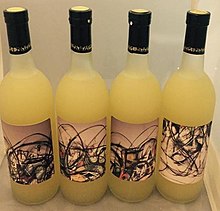|
Limoncello
Limoncello (Italian: [limonˈtʃɛlːo]) is an Italian lemon liqueur mainly produced in southern Italy, especially in the region around the Gulf of Naples, the Amalfi Coast and Sicily. It is the second-most popular liqueur in Italy and is traditionally served chilled as an after-dinner digestif. It is also a popular homemade liqueur, with various recipes available online and in print. Limoncello is made from the zest of lemons and usually has a slightly turbid appearance, which originates from suspended small essential oil droplets. HistoryThe exact origin of limoncello is disputed. The industry trade group Federazione Italiana Industriali Produttori Esportatori ed Importatori di Vini, Acquaviti, Liquori, Sciroppi, Aceti ed affini says that limoncello was created at the beginning of the 1900s by the grandmother of Maria Antonia Farace, who lived in a small guesthouse in Isola Azzurra.[1] US sources[who?] say that it was either invented in Sicily about 100 years ago,[2] or that it was first made on the Amalfi Coast, where several villages and islands claim to be its place of origin.[3] Journalist Kristen Tillotson reports that it may either have been invented by a citrus-grove tender from Azzurra around 1900 or by monks or fishermen much earlier.[3] Production Limoncello is mainly produced in southern Italy, especially in the region around the Gulf of Naples, the Amalfi Coast and Sicily.[4] Traditionally, limoncello is made from the zest of Femminello St. Teresa lemons, also known as Sorrento or Sfusato lemons.[2][5] Lemon zest, or peels without the pith, is steeped in rectified spirit until the oil is released. The resulting yellow liquid is then mixed with simple syrup. Varying the sugar-to-water ratio and the temperature affects the clarity, viscosity, and flavor. It has a slightly turbid appearance, which originates from the presence of small (approximately 100 nanometers) essential oil droplets suspended in the drink. Opaque limoncello is the result of spontaneous emulsification (otherwise known as the ouzo effect) of the sugar syrup and extracted lemon oils.[6] Commercial production was about 15 million liters in 2003.[6] Popularity Limoncello is the second-most popular liqueur in Italy after Campari.[5] ServingLimoncello is traditionally served chilled as an after-dinner digestif.[citation needed] It can also be served as a spritz by mixing it with Prosecco & Lemonade or Soda water. With Limoncello originating from the Amalfi Coast, it is sometimes known as an Amalfi spritz.[7] Alcohol contentAlcohol content can vary widely, especially among homemade variants, but the typical alcohol content is about 30% by volume.[6] VariantsMany variations of limoncello are also available. These include arancello (flavored with oranges), agrumello (flavored with mixed citrus), pistachiocello (flavored with pistachio nuts), meloncello (flavored with cantaloupe), and fragoncello (flavored with strawberry). A version made with milk instead of simple syrup also exists, known as crema di limoncello and is often less alcoholic, at around 17% alcohol content by volume. See alsoReferences
Further reading
External links
|
||||||||||
